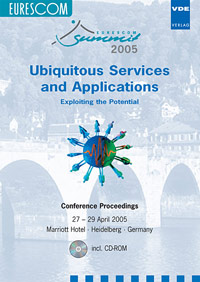Model Driven Integration of Standard Based OSS Components
Konferenz: EURESCOM Summit 2005 - Ubiquitous Services and Applications - Exploiting the Potential
27.04.2005 - 29.04.2005 in Heidelberg, Germany
Tagungsband: EURESCOM Summit 2005 - Ubiquitous Services and Applications
Seiten: 8Sprache: EnglischTyp: PDF
Persönliche VDE-Mitglieder erhalten auf diesen Artikel 10% Rabatt
Autoren:
Georgalas, Nektarios; Azmoodeh, Manooch (BT Group, Ipswich, UK)
Ou, Shumao (University of Essex, UK)
Inhalt:
Telecommunication operators are undergoing massive transformations in order to metamorphose themselves into the ICT world and compete with agile, lean IT organisations. The main challenges are to reduce cost of their OSS, increase agility and architecting OSS infrastructure to cover the IT and communication estate, by increasing reuse of OSS capabilities. The main contributing factors to these challenges are: - Keeping up with churn of technology and platforms, - Cost of in house development, - Launch of OSS for new services and products, - Heavy customisation of COTS in OSS, and - Heavy integration tax (of COTS, legacy and in house developed systems). Our research in BT is focussed on using Model Driven Architecture – MDA technology of OMG in conjunction with other approaches such as use of component based Service Oriented Architecture to OSS (Next Generation OSS - NGOSS of TeleManagement Forum - TMF), and standard OSS capabilities (OSS through Java APIs - OSS/J) to drastically tackle the above cost factors. We have created a vision of an OSS integration environment where all designers and architects in the company can develop/integrate/reuse OSS capabilities through automated tool support in a technology neutral environment using MDA technology. Thus, we will safeguard our intellectual property assets and create coherence in our OSS infrastructure (in contrast with stove-pipe solution approach we currently deploy). Also MDA approach will allow us to achieve a much greater agility in our business as OSS is often on the critical path of any product launch. BT has already recognised the value of a SOA based componentised approach in its 21C network and system transformation programme. We are building the next major step in its effective realisation by using MDA to capture architectural guidelines and design guidelines and automatically generate/integrate OSS applications into existing OSS infrastructure, without the need of delving into technological and platform details of multiplicity of systems and middleware we use. In this paper, we describe our vision and our current work on an OSS testbed for the future where we use advanced MDA tools to automate the business critical integration of our OSS solutions.


